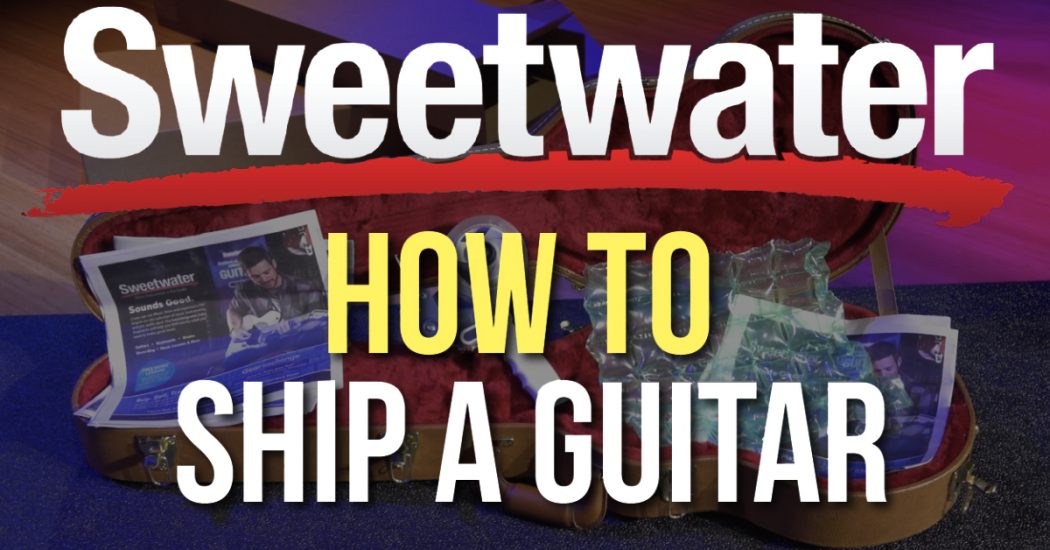
Sweetwater ships tens of thousands of guitars every year, so we know the dangers of shipping a guitar as well as anyone. Our Guitar Shop frequently receives guitars that have not been packaged correctly. We’ve seen everything from minor cracks to a box full of splinters. All of which could easily have been avoided using the steps below. In this article we’ll use common packing materials available at any shipping store and an easy, 3-step method to show you how to ship a guitar.
What You’ll Need…
- 2 Boxes
- Tape
- Newspaper
- Bubble Wrap… lots of it.
*Pro Tip: Packing Peanuts – They’re the worst. They don’t protect guitars well, they’re a huge mess and they’re horrible for the planet. Don’t use them.
Step 1: Protect The Guitar
First, protect the guitar inside the case. A guitar that can move around inside the case is not safe. The key to safely shipping your guitar is stability (the less it moves, the better) and that all starts by securing the guitar inside of its case. Here’s how we do it:
1. Remove Unnecessary Items
Remove anything from the case that you don’t need to include. That means things like a slide, capo, whammy bar.. the list goes on. To prevent dings and scratches during transit, be sure to put loose bridges, truss rod wrenches and other hardware in the case compartment or gig bag pocket.
2. De-tune the Guitar
De-tuning is important (especially for Gibsons) because it relieves some of the tension on the headstock, allowing it to bend without breaking. There’s no need to remove the strings completely, just spin the tuning keys enough to lower the pitch about one whole step.
3. Wrap the Headstock
Wrapping the headstock in bubble wrap helps protect the tuners from the case and vice-versa. It also helps protect the top of the headstock. Tightly wrap a couple rubber bands around the bubbles to keep it from coming loose.
4. Protect the Frets and Pickups
To protect your fretboard, take a folded piece of newspaper and slide it between the strings and the frets. This method also works for protecting your pickups.
5. Fill the Gaps
A guitar that can move inside the case is not safe. Use newspaper or bubble wrap to fill any gaps between the inside of the case and the guitar. This includes the neck joint, under the headstock, and anywhere else that will keep the guitar from moving.
6. The First Shake Test
Shake the case. If you feel or hear any movement when you shake the case, you’re not done protecting the guitar inside the case.
Step 2: Protect The Case
Next, protect the case inside the box. To do this, put a couple layers of bubble wrap at the bottom of the box, wrap your case in bubble wrap and slide it into the box. Next, use more bubble wrap to fill any gaps between the case and box. This includes protecting the top of the case by adding enough packing material to make it nice and snug when you tape it closed. Ensuring that the case doesn’t move inside the box is the safest way for it to travel. Now it’s time for the second shake test. Shake the box. If you feel or hear any movement when you shake the box, you’re not done protecting the case.
Step 3: Protect The Box
Last, use a second box. Grab a slightly larger box and protect the top, bottom, and sides with bubble wrap. Just like before, fill any gaps between the two boxes with bubble wrap before taping it closed. Trust us, double-boxing is the way to go. Now it’s time for the final shake test. Shake the box. The same as before, if you feel or hear any movement when you shake the box, you’re not done protecting the box.
Here at Sweetwater we want to ensure that your guitar arrives to our Guitar Shop in the same condition as when you ship it. If you ever have any questions or concerns regarding the safest way to ship your guitar, please don’t hesitate to contact one of our guitar shipping specialists.


